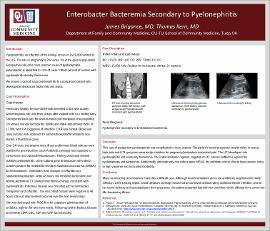| dc.description.abstract | INTRODUCTION: Pyelonephritis, an infection of the kidney, occurs in 16/10,000 women in the U.S. The rate in pregnancy is 2% versus 1% in the general population. Escherichia coli is the most common cause of pyelonephritis. Enterobacter is identified in <3% of cases. Fifteen percent of women with pyelonephritis develop bacteremia. We present a case of acute pyelonephritis in a postpartum patient who developed Enterobacter bacteremia and sepsis.
CASE DESCRIPTION: Previously healthy 16-year-old female presented to ED with acutely worsening back pain and fever 3 days after vaginal birth to a healthy baby. She reported back pain for several weeks but contributed it to pregnancy. On arrival, she was tachycardic, febrile and initial labs showed WBC of 17,000 and UA suggestive of infection. CXR was normal. Blood and urine cultures were obtained. IV sulfamethoxazole/trimethoprim was started; a fluid bolus given. Over 24 hours, she became more ill and preliminary blood cultures were positive for gram-positive cocci. Antibiotic coverage was expanded to vancomycin and piperacillin/tazobactam. Kidney ultrasound showed possible pyelonephritis. Urine cultures grew Enterobacter with blood cultures positive for methicillin-sensitive Staphylococcus aureus and Enterobacter. Antibiotics were changed to cefazolin and piperacillin/tazobactam. After 48 hours, she remained tachycardic and febrile. Abdominal CT showed only kidney changes consistent with pyelonephritis. Infectious Disease was consulted and recommended meropenem and cefazolin. The next blood cultures were negative at 48 hours. Clinical improvement occurred over the next several days. She was discharged with PICC line for outpatient administration of antibiotic regimen for two more weeks. Follow-up with Infectious Disease and weekly CMP, CBC, ESR and CRP was scheduled.
DISCUSSION: This case of postpartum pyelonephritis was complicated in many aspects. The patient’s recent pregnancy created delay in care as back pain and UTI symptoms were easily mistaken for pregnancy/postpartum-associated pain. The UTI developed into pyelonephritis and eventually bacteremia. The initial antibiotic regimen, targeted at UTI, proved ineffective against the pyelonephritis and bacteremia. Additionally, although only one culture grew MSSA, the antibiotic course should have covered it due to high virulence and associated morbidity.
Many surrounding circumstances made this a difficult case. Although recommendations are to use antibiotics targeted at the likely infection, when treating sepsis, broad spectrum coverage should not be narrowed without ruling out blood stream infection. Due to her recent delivery and associated pain from pregnancy, this patient presented late with her condition, which allowed for a severe and life-threatening illness. | en_US |

